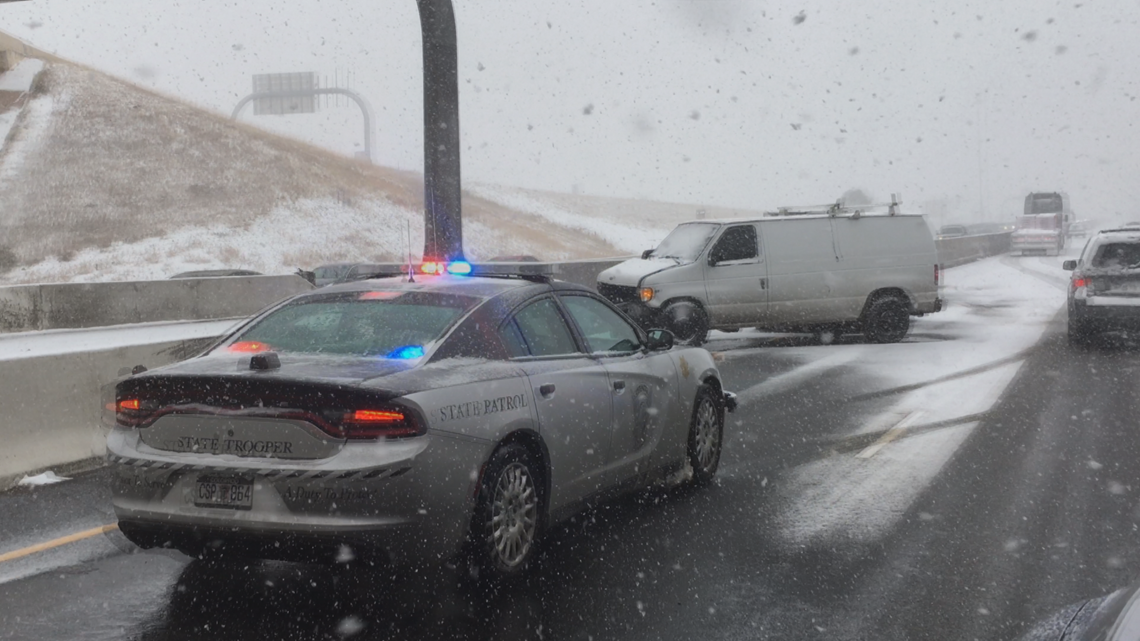DENVER, Colorado — Snow slammed the tail end of the morning commute during Denver's first snowstorm of the season Thursday.
Two heavy snow bands hit between 7:30 am and 10:30 am.
The Denver Police Department (DPD) said it responded to 96 crashes during the morning commute.
“95 percent of all crashes, in any condition, are because of user error, that means they are completely preventable,” said Skyler McKinley with AAA Colorado.


The forecast was for 1-3 inches of snow, and there ended up being 2-4.
AAA said you can't blame the plows either.
"There are always things that state and local governments can do better, but your car can handle slippery conditions. What it can't handle is slippery conditions at high speeds," said McKinley.
AAA Colorado answered some questions about how to help make our winter commutes a little more bearable:
(Editor's Note: The following responses may have been edited for context and clarity.)
9NEWS: Besides driving too fast for road conditions, what else causes car crashes?
McKinley: The two biggest contributing factors to winter driving accidents, other than speed, are tires and visibility.
How much tire tread should you have?
The easiest way to explain it is by using the quarter test. Just get George Washington’s head on the quarter, point it so the top of his head is facing down, and if any part of his head is covered, you have enough tread.
My tire pressure warning comes on in the morning. Should I worry about that?
Cold weather will lower your tire pressures. Typically by 1 PSI for every 10 degrees Fahrenheit. It's time to fill your tires to the recommended cold weather maximum tire pressure.
That pressure fills out your tread, so your tread is able to scoop in liquid, and drive over snow. The tread doesn’t work if there’s not enough pressure pressing outward on the tread.
How important are wiper blades to visibility?
If you can't see, you can't drive. Wiper blades are the 'Rodney Dangerfield' of safety equipment. They just don't get any respect. You should replace your wiper blades at least every 6 months. And make sure your window washer fluid is full.
What's another way visibility is impacted?
Colorado law requires you to clear off your entire vehicle before your drive. That includes the hood and the roof. As you drive, that snow can fly into your windshield or onto other vehicles
Your press release mentions batteries. How does that impact bad driving?
Most of the wear on your battery is done in the heat of the summer, but it's winter when you notice it.
At 32 degrees your battery is about 15% less effective, and at 0, it's only half as effective. Most of the calls our crews got were related to dead batteries or cars not starting. Then people enter into traffic stressed and frustrated because even if they built in extra time, the lost a lot of that for replacing their battery.
Are 4-wheel-drive vehicles really that better in the snow?
Yes they make a huge difference, but 4-wheel-drive doesn't mean 4-wheel-stop. So you might have an SUV with top of the line tires with excellent tread, that's going to help you get going a lot easier, but it doesn't really help you stop better than any other vehicle.
Can you explain what's new with the traction law?
The big change is that the traction law is always in place, every day, rain, snow, or shine on the I-70 mountain corridor between the Morrison exit and the Dotsero exit. That's from September to May.
What are the vehicle requirements to travel that stretch of highway?
You have to have a 4-wheel-drive vehicle with sufficient tread. 2-wheel-drive vehicles are allowed if they have snow tires or all-season tires that have that specific mud plus snow (M+S) designation. If you don't meet those requirements, you need to be carrying chains, auto socks, or other traction equipment.
SUGGESTED VIDEOS | Science is Cool

